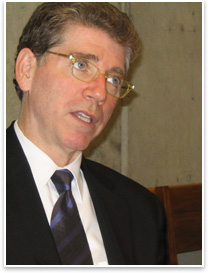
Summary: Daniel S. Friedman, FAIA, was appointed dean of the University of Washington College of Architecture and Urban Planning in July, after serving as director of the School of Architecture at the University of Illinois at Chicago for three years. He is the cofounder and past editor of Practices magazine, co-editor of Plumbing: Sounding Modern Architecture, and a frequent contributing writer to professional journals, magazines, and critical anthologies. Friedman also led the 2005 Midwestern session of the Mayors’ Institute on City Design, which paired mayors from eight regional cities with 12 leading Chicago architects, each of whom undertook selected design problems related to transportation infrastructure and land use. Occupation: Architect and educator, in that order. Education: MArch from the University of Wisconsin; master of science and doctoral degree in architectural theory from the University of Pennsylvania. Hobby: Watching the airline industry. It’s true. I don’t fish. I’m not an outdoor type. When I run, it’s not as a hobby. I’m too inefficient to have a hobby. If there’s a spare minute that I’m not spending with my family, then I spend it at work, but I do watch the airline industry very closely. I’m a big fan of aviation technology and aeronautics. Place you most want to visit: The Potala Palace in Llasa, Tibet. Greatest professional challenge: Reconciling practice and education. Greatest reward: Working in a public university. Most frequently assigned textbook: As a principle, I don’t use a textbook. Like most architecture professors I know, I assemble my own “textbooks” by compiling essays, articles, and excerpts specific to certain courses of instruction. Critical reading has levels like any skill. You have to start with fundamentals and build to more nuanced and complex logics of argument. I generally teach introductory theory classes to undergraduate students and advanced theory seminars to grad students; the course of reading is obviously very different. But if a beginning student were to come up to me after class and express an interest, I’d probably recommend The Meaning of Modern Art: a Philosophical Interpretation by Karsten Harries. Source of inspiration: Novels. I think what distinguishes good building from bad building is precisely the same thing that distinguishes good writing from bad writing, good music from bad music, good art from bad art. If you push me into a corner and ask “What one thing distinguishes trivial from non-trivial?” I’d answer: Non-trivial works put us in touch with the ambiguity of human experience. Good fiction mines ambiguity. I’m inspired by any work—book or building—that allows me to live more fully in my own skin. To put it in the words of Ezra Pound, “Literature is news that stays news.” Likewise architecture. Advice for young and future architects: Read. Direction of architectural education: Fully integrated practice. Forthcoming for the profession: Broad public confidence in the transformative power of design. |
||
Copyright 2006 The American Institute of Architects. All rights reserved. Home Page |
||
news headlines
practice
business
design
A
printer-friendly version of this Doer‘s Profile is available.
Download the
PDF file.

